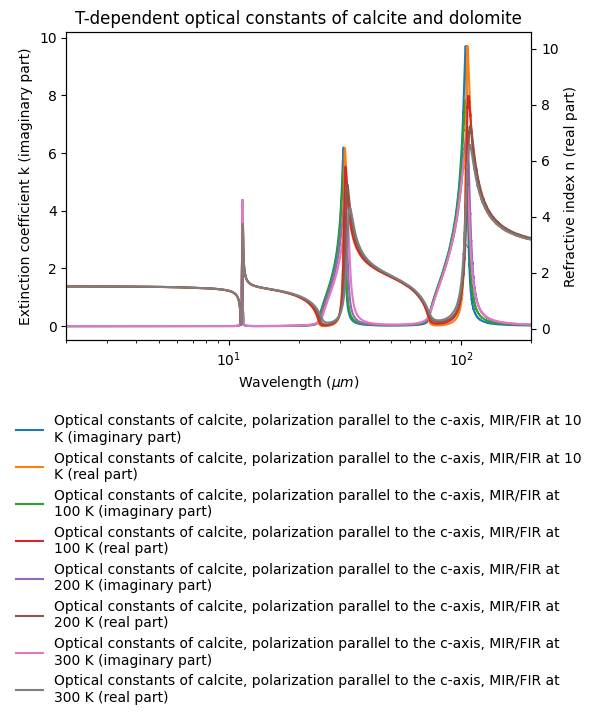- DOI
- 10.26302/SSHADE/EXPERIMENT_SB_20210115_001
- Data reference
- Posch, Thomas; Mutschke, Harald; Henning, Thomas (2005): T-dependent optical constants of calcite and dolomite. SSHADE/DOCCD (OSUG Data Center). Dataset/Spectral Data. https://doi.org/10.26302/SSHADE/EXPERIMENT_SB_20210115_001
- Publications
- Database(s)
- Experimentalists
- Type(s)
- laboratory measurement
- Description
- Optical constants are obtained by reflectance measurements with polarized light in a temperature range of 10 K to 300 K
- Number of spectra
- 16
- Variable type(s)
-
- sample composition
- polarization
- temperature
- Instrument
- BRUKER 113v – reflection Mid-IR
- Standard medium
- vacuum
- Observation mode
- spectrum
- Spectral range type(s)
- MIR
- Valid spectral range(s)
-
Min - Max (${\mu}m$) Sampling (${\mu}m$) Resolution (${\mu}m$) Position accuracy (${\mu}m$) Absorption edge #1 2.0 - 25.0 - Comments
- The MIR reflection measurements were performed at room temperature only (without cryostat).
Definition: incidence and emergence angles are positive with origin at nadir, and vary in same direction. Azimuth origin (increasing clockwise) is for i = e (opposition geometry).
- Observation geometry
- specular
- Observation mode
- fixed angles
- Incidence angle
- 12.0°
- Emergence angle
- 12.0°
- Resolution illumination
- 6.0°
- Resolution observation
- 6.0°
Illumination
- Type of polarization
- no
Observation
- Type of polarization
- linear
- Type of polarizer
- wire-grid polarizer (KRS5)
- Polarization angle
- 0.0°
- Comments
- parallel to the optical axis of the crystal
- Observation mode
- single spot
- Spatial resolution
- 5.0 $mm$
- Instrument
- BRUKER 113v – reflection Far-IR
- Sample holder
- A continuous-flow liquid helium cryostat (Cryovac) was used for temperatures below 300 K.
- Standard medium
- vacuum
- Observation mode
- spectrum
- Spectral range type(s)
- FIR
- Valid spectral range(s)
-
Min - Max (${\mu}m$) Sampling (${\mu}m$) Resolution (${\mu}m$) Position accuracy (${\mu}m$) Absorption edge #1 15.0 - 200.0
Definition: incidence and emergence angles are positive with origin at nadir, and vary in same direction. Azimuth origin (increasing clockwise) is for i = e (opposition geometry).
- Observation geometry
- specular
- Observation mode
- fixed angles
- Incidence angle
- 12.0°
- Emergence angle
- 12.0°
- Resolution illumination
- 6.0°
- Resolution observation
- 6.0°
Illumination
- Type of polarization
- no
Observation
- Type of polarization
- linear
- Type of polarizer
- wire-grid polarizer (PE)
- Polarization angle
- 0.0°
- Comments
- parallel to the optical axis of the crystal
- Observation mode
- single spot
- Spatial resolution
- 5.0 $mm$
- Date begin - end
- 2005-02-22 - 2005-03-16
Versions
- Release date
- 2021-02-10 12:23:23+0000 UTC
- Version (Date)
- #1 (2021-02-10 12:23:23+0000 UTC, Updated: 2021-02-10 12:23:23+0000 UTC)
